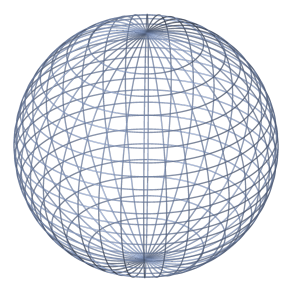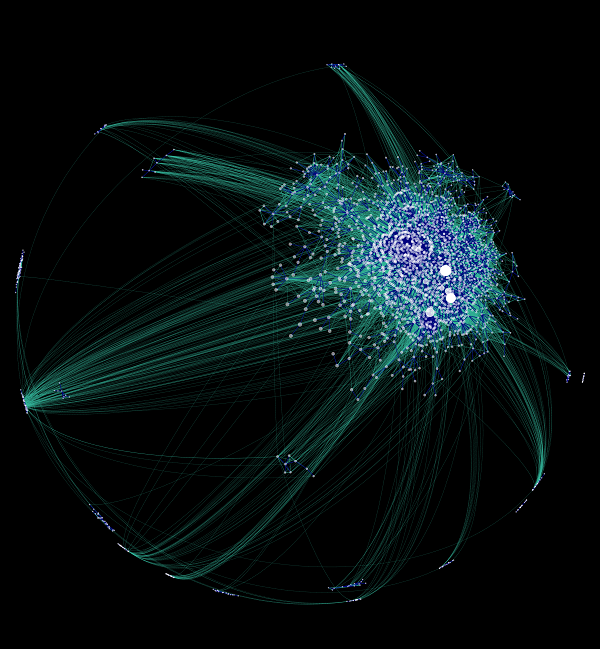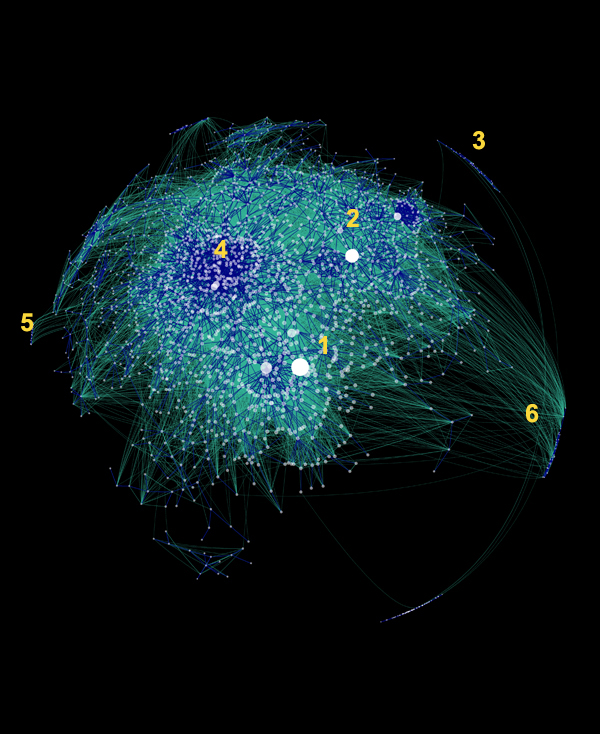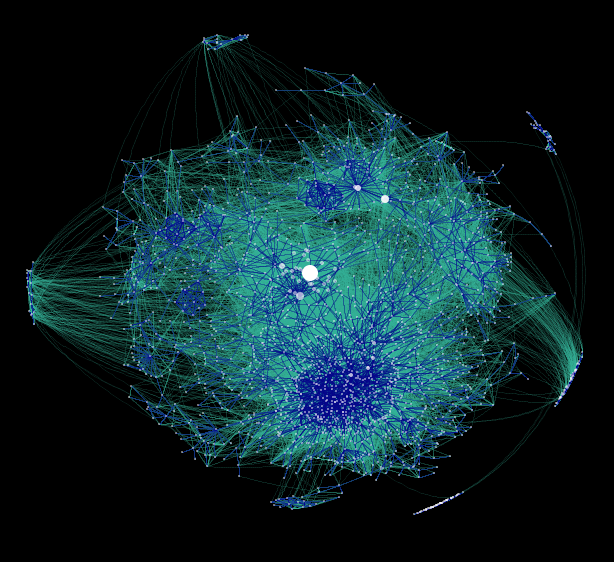You are here: Foswiki>Dmi Web>TheHistoryOfTheTwoWayLink (05 Apr 2012, RichardRogers)Edit Attach
Timeline
1965: Xanadu
Ted Nelson's 'discrete hypertext' focus on the link. (pdf) Xanadu, a (mainly) conceptual system for linking hypertext is based on transclusion: "In computer science, transclusion is the inclusion of part of a document into another document by reference. It is a feature of substitution templates. Some hypertext systems, including Ted Nelson's Xanadu Project, support transclusion. For example, an article about a country might include a chart or a paragraph describing that country's agricultural exports from a different article about agriculture. Rather than copying the included data and storing it in two places, a transclusion embodies modular design, by allowing it to be stored only once (and perhaps corrected and updated if the link type supported that) and viewed in different contexts. The reference also serves to link both articles." (Wikipedia)1989: The World Wide Web
Tim Berners Lee: original web document: the two way link Make distinction between conceptual/proposed WWW and actual WWW The Refback in bulletin boards. (vBulletin )1999: The blogosphere
The blogosphere as a connected sphere through (perma)links.- 1999: First usage of the word blogosphere by Brad L. Graham at BradLands.com on September 10, 1999.
Goodbye, cyberspace! Hello, blogiverse! Blogosphere? Blogmos? (Carl Sagan: "Imagine billions and billions and billions of blogs.") - Brad L. Graham
- 2001: First claimed proposal of the word blogosphere by William Quick on December 30, 2001
I PROPOSE A NAME for the intellectual cyberspace we bloggers occupy: the Blogosphere. Simple enough; the root word is logos, from the Greek meaning, variously: In pre-Socratic philosophy, the principle governing the cosmos, the source of this principle, or human reasoning about the cosmos; Among the Sophists, the topics of rational argument or the arguments themselves. (The American Heritage® Dictionary of the English Language) - William Quick
The term resembles the older word "logosphere" (from Greek logos meaning word, and sphere, interpreted as world), the "the world of words," the universe of discourse. It also resembles the term "noosphere" (Greek nous meaning mind). - WikipediaA space with blogs versus a space of discourse made possible through blogging.
- Sphere visualization:

- Blogosphere visualization:

- Blogosphere visualization:

- Blogosphere visualization:

Five types of links within the Blogosphere
A proposed taxonomy of links in blogs:- 1. The permalink (post.title)
- 2. Citations (links in the post)
- 1. Links to other blogs (links within the blogosphere)
- 2. Links to other sites (links outside the blogosphere, eg news sites)
- 3. Linkbacks
- 1. Trackback
- 2. Pingback
- 4. Comments:
- 1. Linked name (optional promotion of your site)
- 2. Links in comments (recommendation)
- 5. Blogroll
1. The permalink
A permalink, or permanent link, is a URL that points to a specific blog or forum entry after it has passed from the front page to the archives. Because a permalink remains unchanged indefinitely, it is less susceptible to link rot. Most modern weblogging and content-syndication software systems support such links. Other types of websites use permanent links, but the term permalink is most common within the blogosphere. (Wikipedia)
2. Citations
Citations are links within blogposts, referencing sources.3. Linkbacks
Trackback and Pingback used outside of the blogosphere in news sites, such as CNET (2004): http://news.com.com/TrackBack+and+Pingback+supported+by+CNET+News.com/2030-9368_3-5462850.html?tag=item "CNET News.com is pleased to introduce support for TrackBack and Pingback as additional tools to help readers follow the flow of interactive content. Anyone linking to a CNET News.com story who sends the proper notification will get a link back in return." Proper notification = Trackback or Pingback. (Anno 2007 no Trackback or Pingback visible on CNET. They do however have Talkback, which is actually a comment. Blogs on bbc.co.uk don't have Trackback or Pingback) TrackbackInterestingly, two-way links were the goal of early hypertext systems like Xanadu. Hypertext purists have celebrated trackbacks as a step towards two way links. But note that trackbacks are not properly two-way--rather, they are really (potentially) symmetrical one-way links that create the effect of two way links.(O'Reilly)
4. Comments
Links in comments are generally either identification/promotion, i.e. a link to the commentor's blog or homepage, or a recommendation within the comment text.5. Blogroll
A list of blogs, usually placed in the sidebar of a blog, that reads as a list of recommendations by the blogger of other blogs. (Wikipedia)
Literature
- Bush, Vannevar. 'As We May Think.' Atlantic Monthly, 176, 1 (July 1945) 101-108. http://www.theatlantic.com/doc/194507/bush
- O'Reilly, Tim. 'What Is Web 2.0.' 30 September 2005. http://tim.oreilly.com/pub/a/oreilly/tim/news/2005/09/30/what-is-web-20.html?page=3
- Nelson, Theodor. 'Xanalogical structure, needed now more than ever: parallel documents, deep links to content, deep versioning, and deep re-use.' ACM Computing Surveys (CSUR). Vol. 31, Issue 4 (December 1999) http://www.cs.brown.edu/memex/ACM_HypertextTestbed/papers/60.html
- Elmer, Greg. 'Re-tooling the Network: Parsing the Links and Codes of the Web World.' (2006). http://con.sagepub.com/cgi/reprint/12/1/9.
Various
- 2waylink.html: History of the (two-way) link animation
- 2waylink.swf: History of the (two-way) link animation
Tags: , view all tags
| I | Attachment | Action | Size | Date | Who | Comment |
|---|---|---|---|---|---|---|
| |
2waylink.html | manage | 578 bytes | 14 Jul 2007 - 14:25 | UnknownUser | History of the (two-way) link animation |
| |
2waylink.swf | manage | 16 K | 14 Jul 2007 - 14:25 | UnknownUser | History of the (two-way) link animation |
| |
Sphere-wireframe.png | manage | 147 K | 15 Jul 2007 - 13:41 | UnknownUser | Sphere visualization |
| |
blogosphere-hi-res1-scale1.png | manage | 272 K | 15 Jul 2007 - 13:46 | UnknownUser | Blogosphere visualization |
| |
blogosphere.jpg | manage | 322 K | 15 Jul 2007 - 13:40 | UnknownUser | Blogosphere visualization |
| |
newblog-crop.png | manage | 373 K | 15 Jul 2007 - 13:45 | UnknownUser | Blogosphere visualization |
Edit | Attach | Print version | History: r19 < r18 < r17 < r16 | Backlinks | View wiki text | Edit wiki text | More topic actions
Topic revision: r19 - 05 Apr 2012, RichardRogers
 Copyright © by the contributing authors. All material on this collaboration platform is the property of the contributing authors.
Copyright © by the contributing authors. All material on this collaboration platform is the property of the contributing authors. Ideas, requests, problems regarding Foswiki? Send feedback


